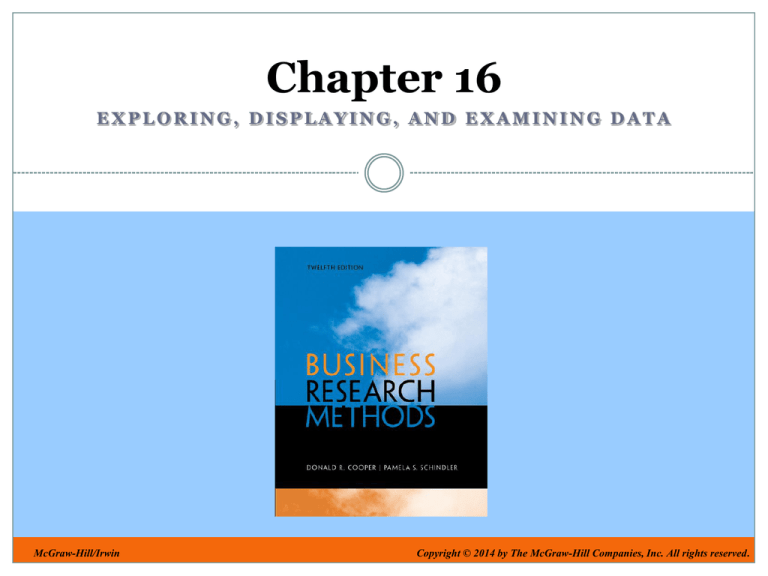
Chapter 16
EXPLORING, DISPLAYING, AND EXAMINING DATA
McGraw-Hill/Irwin
Copyright © 2014 by The McGraw-Hill Companies, Inc. All rights reserved.
Learning Objectives
Understand . . .
That exploratory data analysis techniques
provide insights and data diagnostics by
emphasizing visual representations of the data.
How cross-tabulation is used to examine
relationships involving categorical variables,
serves as a framework for later statistical
testing, and makes an efficient tool for data
visualization and later decision-making.
16-2
Pull Quote
“On a day-to-day basis, look for inspiration and
ideas outside the research industry to influence
your thinking. For example, data visualization
could be inspired by an infographic you see in a
favorite magazine, or even a piece of art you
see in a museum.”
Amanda Durkee, partner
Zanthus
16-3
Researcher
Skill
Improves
Data
Discovery
DDW is a global player in
research services. As this
ad proclaims, you can
“push data into a template
and get the job done,” but
you are unlikely to make
discoveries using a
template process.
16-4
Exploratory Data Analysis
Exploratory
Confirmatory
16-5
Data
Exploration,
Examination,
and Analysis
in the
Research
Process
16-6
Research Values the Unexpected
“It is precisely because the unexpected jolts
us out of our preconceived notions, our
assumptions, our certainties, that it is such a
fertile source of innovation.”
Peter Drucker, author
Innovation and Entrepreneurship
16-7
Frequency:
Appropriate Social Networking Age
16-8
Bar Chart
16-9
Pie Chart
16-10
Frequency Table
16-11
Histogram
16-12
Stem-and-Leaf Display
5
6
7
8
9
10
11
12
13
14
15
16
17
18
19
20
21
455666788889
12466799
02235678
02268
24
018
3
1
06
3
36
3
6
8
16-13
Pareto Diagram
16-14
Boxplot Components
16-15
Diagnostics with Boxplots
16-16
Boxplot Comparison
16-17
Mapping
16-18
SPSS Cross-Tabulation
16-19
Percentages in Cross-Tabulation
16-20
Guidelines for Using Percentages
Don’t average percentages
Don’t use too large a
percentage
Don’t use too small a base
Changes should never
exceed 100%
Higher number is the
denominator
16-21
Cross-Tabulation with Control and
Nested Variables
16-22
Automatic Interaction Detection (AID)
16-23
Exploratory
Data
Analysis
This Booth Research
Services ad suggests that
the researcher’s role is to
make sense of data
displays.
Great data exploration and
analysis delivers insight
from data.
16-24
Key Terms
Automatic interaction
detection (AID)
Boxplot
Cell
Confirmatory data
analysis
Contingency table
Control variable
Cross-tabulation
Exploratory data
analysis (EDA)
Five-number summary
Frequency table
Histogram
Interquartile range
(IQR)
Marginals
Nonresistant statistics
Outliers
Pareto diagram
Resistant statistics
Stem-and-leaf display
16-25
Chapter 16
ADDITIONAL DISCUSSION OPPORTUNITIES
McGraw-Hill/Irwin
Copyright © 2014 by The McGraw-Hill Companies, Inc. All rights reserved.
Snapshot: Novation
No standarded vocabulary
across companies
Serve variety of users
Ad hoc analysis with
sophisticated visualizations
Big data with sophisticated
analytical tool.
16-27
Snapshot:
Digital Natives vs. Digital Immigrants
30 subjects = 15 natives,
15 immigrants
Monitored media behaviors
300 hours of real-time data
Biometric Monitoring:
emotional engagement
16-28
Snapshot: Empowering Excel
16-29
Snapshot: Internet-age Researchers
“The ability to take data—to
be able to understand it, to
process it, to extract value
from it, to visualize it, to
communicate it—that’s going
to be a hugely important skill
in the next
decades . . . .”
16-30
Research Thought Leader
“As data availability continues to increase, the
importance of identifying/filtering and analyzing
relevant data can be a powerful way to gain an
information advantage over our competition.”
Tom H.C. Anderson
founder & managing partner
Anderson Analytics, LLC
16-31
PulsePoint:
Research Revelation
65
The percent boost in company
revenue created by best practices in
data quality.
16-32
Geograph:
Digital Camera Ownership
16-33
CloseUp: Working with
Data Tables
16-34
CloseUp: Original Data Table
16-35
CloseUp: Arranged by Spending
Most to Least
16-36
CloseUp:
Arranged by Average Annual
Purchases, Most to Least
16-37
CloseUp:
Arranged by Average Transaction,
Most to Least
16-38
CloseUp:
Arranged by Estimated Average
Transaction, Least to Most
16-39
Chapter 16
EXPLORING, DISPLAYING, AND EXAMINING DATA
McGraw-Hill/Irwin
Copyright © 2014 by The McGraw-Hill Companies, Inc. All rights reserved.
Photo Attributions
Slide Source
4 Courtesy of Radius Global Market Research
18 Courtesy of RealtyTrac
21 Vstock/Alamy
24 Courtesy of Booth Research Services
27 Courtesy of Novation
28 Realistic Reflections
29
Courtesy of DecisionPro; Digital Vision/Getty Images
30 Vstock LLC/Getty Images
16-41





